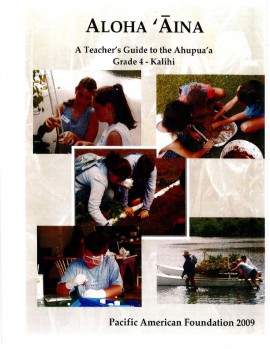 Ahupuaʻa – Introduction
Ahupuaʻa – Introduction
– Essential Question: How were the people, land, and ocean connected in early Hawaiʻi?
– Unit Map
– Presentation Rubric
Lesson 1: Our Ahupuaʻa
– Essential Question: How do moʻolelo teach us about the land and people of old Hawaiʻi?
– Learning Log 1: Labeling Our Ahupuaʻa
– Moʻolelo: The Sacred ʻUlu Tree
– Learning Log 2: Moʻolelo Discussion
– Map: Kalihi and Kapālama Ahupuaʻa
– Moʻolelo: Hapuʻu and Kalaihauola
– Moʻolelo: Kapukawaiokalihi – The Destroyed Stones
– Extended Activity: Moʻolelo Discussion
Lesson 2: The Case of the Strongest Cord
– Essential Question: Why was cordage valuable in old Hawaiʻi, and what properties make cordage strong and flexible?
– Student Cordage Research Stations
– Student Reading: About Cordage
– How to Test Cordage
– Learning Log 3: A Scientific Investigation
– Learning Log 4: A Day in the Life of Old Hawaiʻi
– Cordage-Making Instructions
Lesson 3: Engineering Ingenuity
– Essential Question: How did Hawaiians engineer shoreline fishponds to grow fish, while maintaining water quality and preventing siltation?
– Learning Log 5: Loko Kuapā
– Student Reading: Loko Kuapā
Lesson 4: Mauka – Makai Connection
– Essential Question: How did the Hawaiian system of irrigating loʻi allow people to use water wisely in their ahupuaʻa?
– Moʻolelo: Kapukawaiokalihi – Fresh Water for the ‘Awa
– Learning Log 6: Loʻi Irrigation
– Model-Building Instructions
– Learning Log 7: Water Distribution through a System of Loʻo Kalo
Lesson 5: Giving Back to the ʻĀina
– Essential Question: How do Hawaiian practices nurture a healthy relationship to the ʻāina, and how can we give back to the ʻāina today?
– Learning Log 8: Student Activities
– Student Reading: Measuring Length and Distance
Huakaʻi
– Mokauea Island and Fishpond
– Loʻi Kalo and Garden
– Fishpond and Loʻi Ukana
Assessment
– Pre-Post Test
